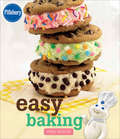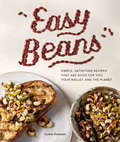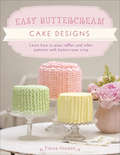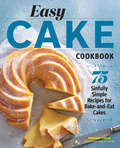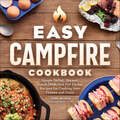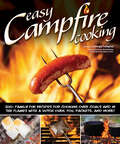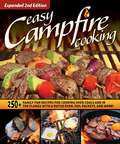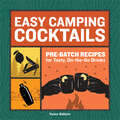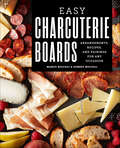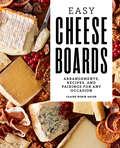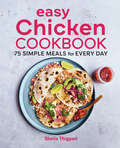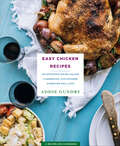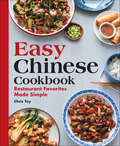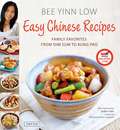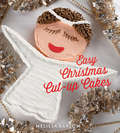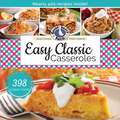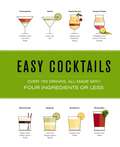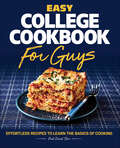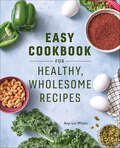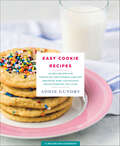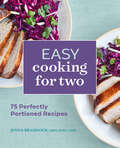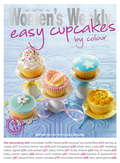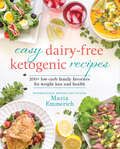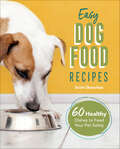- Table View
- List View
Easy Baking: Wiley Selects (Pillsbury Cooking)
by Pillsbury EditorsBake it easy with Pillsbury! Simple treats using refrigerated dough—including kid-friendly recipes. Nothing beats home-baked treats hot out of the oven. Now Pillsbury gives you more than twenty super-easy recipes for every occasion—tempting cookies and bars, crowd-pleasing holiday favorites, and delectable desserts. You'll even find fun recipes to bake with your kids. All of the recipes use refrigerated dough products to save you time and effort. Make Perfect Apple Pie * Strawberry Kiwi Tart * Mocha Macaroon Torte * Happy Face Cookie Pops * Maple Walnut Pie Bars * Coffee Shop Cookies * and more
Easy Beans: Simple, Satisfying Recipes That Are Good for You, Your Wallet, and the Planet
by Jackie FreemanA fresh approach to cooking with one of our most versatile, nutritious and inexpensive pantry staples! Beans are a &“superfood&” and a budget-conscious, plant-based protein for meat and non-meat eaters alike. An excellent everyday option, they&’re are easy to make the main focus of a meal (breakfast, lunch, dinner) or to sneak into something for an extra boost (think smoothies!). The cookbook uses popular and widely available beans, pulses, and lentils, and includes forty simple, delicious recipes for dips and spreads, salads and soups, as well as for mains. Whether you&’re stocked up on dried or canned beans, there&’s plenty of inspiration here. Liven up your weekly meals with this hearty, healthy staple. Recipes include: Pinto Bean Enchiladas with Zucchini and Spinach Turkey and White Bean Chili Split Pea Soup with Bacon, Lemon, and Fresh Herbs Huevos Rancheros Sandwiches Butter Bean and Walnut Dip Vietnamese Black Bean Sticky Rice Vegan Black-Eyed Pea Jambalaya Red Lentil Stew with Dried Apricots Cauliflower and Lima Bean Gratin Dried Cherry Pilaf with Chickpeas and Pistachios Bean Bourguignon (with or without beef) Coconut Curry Split Pea Dal
Easy Buttercream Cake Designs: Learn How to Pipe Ruffles and Other Patterns with Buttercream Icing
by Fiona PearceDo you dream of being able to make beautiful decorated cakes for any occasion? Easy Buttercream Cake Designs will teach you all of the essential buttercream cake decorating techniques you need to know to create your own amazing designs.Includes 3 gorgeous pastel-coloured cake projects, piped with buttercream, that are impressive and stylish.Plus a free video demonstrations, available online, to teach the best way of using buttercream to pipe ruffles onto a cake.
Easy Cake Cookbook: 75 Sinfully Simple Recipes for Bake-and-Eat Cakes
by Miranda CouseBake your cake and eat it too—super easy recipes for cake when you want it The Easy Cake Cookbook is the ultimate guide for cake lovers who are big on taste—but short on time. If you're a busy home baker or a cake-loving beginner, this cake cookbook offers friendly, fail-safe advice so you can bake fast and flavorful cakes whenever you have the craving. The Easy Cake Cookbook gets you baking with an easy-to-follow cake-making intro, complete with supportive step-by-step advice on choosing the perfect pan, prepping your workspace, and more. Try your hand at dozens of tasty recipes—all mixed and ready to bake in the time it takes your oven to preheat. The Easy Cake Cookbook includes: Take the cake—Become an ace of cakes with this cake cookbook using easy instructions for measuring, mixing, and more. Pieces of perfection—Bake 75+ mix-and-bake cakes that are delicious right out of the pan, such as coffee cakes, Bundt cakes, skillet cakes, and more. Top it off—Up the wow factor of your cakes using a selection of optional but simple and scrumptious recipes for frostings, glazes, and ganache. Sweeten up your day-to-day with delightful and delectable cakes from scratch using the Easy Cake Cookbook.
Easy Campfire Cookbook: Simple Skiller, Skewer, Dutch Oven, and Foil Packet Recipes for Cooking over Flames and Coals
by Mountain DudeDiscover how easy cooking over a campfire can be Camping in the great outdoors doesn't mean cookouts have to be limited to hot dogs on a stick. With the help of four simple tools—a cast iron skillet, a Dutch oven, skewers, or foil—this beginner-friendly cookbook shows you how to serve up hot and delicious meals fresh off your campfire.What sets this campfire cookbook apart:Campfire cooking basics—Learn how to build a cookout-ready campfire, which ingredients to bring along versus what to prep at home, how to best pack your cooler, and more.Fun and easy recipes—From juicy camp burgers to triple berry cobbler, discover exciting new twists on campfire classics and creative new dishes that are sure to please.Clear organization—Recipes are organized into sections for each of the four tools, making it simple to find the right recipe for the tools you have.You won't even miss your kitchen with this easy-to-follow camp cookbook.
Easy Campfire Cooking: 200+ Family Fun Recipes for Cooking Over Coals and In the Flames with a Dutch Oven, Foil Packets, and More!
by Colleen DorseyOver two hundred easy, family recipes you can make over an outdoor fire, whether you&’re camping out in the woods, or in your own backyard. Whether you are heading out on a camping trip or simply enjoying a backyard bonfire, this book will satisfy your appetite. You&’ll find many recipes for a variety of fun cooking methods like cooking on a stick, in a foil packet, with a Dutch oven, in a skillet, with a pie iron, and more. Great for scouting groups, Easy Campfire Cooking is filled with tips, campfire safety, and techniques on how to build the perfect cooking fire. From breakfast treats, to hot dogs, to s&’mores and more—you&’ll find recipes the whole family will love. Best of all, cooking over a fire brings together family and friends to enjoy food and fun in a relaxing atmosphere.Inside Easy Campfire Cooking, you&’ll find recipes for:Stick &‘Taters, page 21Tropical Seafood Skewers, page 30Honey Mustard Chicken Packets, page 50Hashbrown Pie, page 66Kayak Tuna Mac, page 91Starry Night Chili, page 106Fireside Pizza, page 117&“Full of handy how-tos, tips, and recipes, Easy Campfire Cooking is accessible to everyone, no matter how strapped to city life you are. It is a reminder that the simplicity of campfire cooking is satisfying not only because we are &“going back,&” but because we are gathering together around the fire among friends.&” —Georgia Pellegrini, author of Food Heroes
Easy Campfire Cooking: 200+ Family Fun Recipes for Cooking Over Coals and In the Flames with a Dutch Oven, Foil Packets, and More!
by Easy Campfire Cooking, Expanded 2nd EditionOver two hundred easy, family recipes you can make over an outdoor fire, whether you&’re camping out in the woods, or in your own backyard. Whether you are heading out on a camping trip or simply enjoying a backyard bonfire, this book will satisfy your appetite. You&’ll find many recipes for a variety of fun cooking methods like cooking on a stick, in a foil packet, with a Dutch oven, in a skillet, with a pie iron, and more. Great for scouting groups, Easy Campfire Cooking is filled with tips, campfire safety, and techniques on how to build the perfect cooking fire. From breakfast treats, to hot dogs, to s&’mores and more—you&’ll find recipes the whole family will love. Best of all, cooking over a fire brings together family and friends to enjoy food and fun in a relaxing atmosphere.Inside Easy Campfire Cooking, you&’ll find recipes for: Stick &‘Taters, page 21 Tropical Seafood Skewers, page 30 Honey Mustard Chicken Packets, page 50 Hashbrown Pie, page 66 Kayak Tuna Mac, page 91 Starry Night Chili, page 106 Fireside Pizza, page 117 &“Full of handy how-tos, tips, and recipes, Easy Campfire Cooking is accessible to everyone, no matter how strapped to city life you are. It is a reminder that the simplicity of campfire cooking is satisfying not only because we are &“going back,&” but because we are gathering together around the fire among friends.&” —Georgia Pellegrini, author of Food Heroes
Easy Camping Cocktails: Pre-Batch Recipes for Tasty, On-the-Go Drinks
by Tucker BallisterCheers to delicious camping cocktails What pairs well with the satisfying crackle of a campfire? An equally satisfying cocktail, of course! With this ingenious guide, you can hit the trail with an exciting array of drinks. Discover all the essential tools and tips you'll need in order to prepare the perfect on-the-go cocktail for a wilderness happy hour. Travel-friendly tipple—Get expert advice on how to successfully pack your cocktails, from pre-batching at home to the best carrying methods. Recipes for all types of camping—Shake and stir your way through 50 classic and contemporary cocktails—sangria for backpacking, 7-and-7 for car camping, or Cucumber Lemonade Chiller for RV or cabin. A hint of nature—Up your mixology game as you learn how to forage for natural ingredients like edible flowers and wild berries. Kick back at the campsite and enjoy a well-earned drink with this camping cocktails cookbook.
Easy Charcuterie Boards: Arrangements, Recipes, and Pairings for Any Occasion
by Marco Niccoli Aubrey NiccoliElevate any gathering with beautiful charcuterie boardsFrom sophisticated date-night dinners to show-stopping party spreads that will get guests talking, charcuterie boards offer the perfect opportunity to connect over delicious, shared food. Easy Charcuterie Boards is a charcuterie cookbook that shows you how to pair cured meats with fresh cheeses and homemade accompaniments, then place them on a platter in elegant arrangements fit for any occasion. Inside this charcuterie board book, you'll find 30 charcuterie and cheese boards that can serve groups of any size, along with simple recipes for condiments, breads, jams, pickles, and other spectacular snacks and spreads.Artful appetizers—Discover the five elements of a beautiful board and get detailed instructions for creating a visually balanced spread that's almost too pretty to eat!Drink pairings—Take your boards to the next level with suggestions for beers, wines, and mixed cocktails that perfectly complement the flavors of each one.Perfect for entertaining—This book is your go-to guide for hosting a classy party, giving a memorable gift - or throwing together a quick cheese plate dinner for yourself.Get ready for a taste of easy and inspiring charcuterie board recipe ideas!
Easy Cheese Boards: Arrangements, Recipes, and Pairings for Any Occasion
by Claire Robin AdlerCreate a feast for your eyes and taste buds with this easy guide to cheese boards A cheese board makes a tasty and elegant addition to any occasion. Whether you're putting together a party platter or a simple appetizer plate for two, all that's needed is this foolproof guide and a love of fromage. Easy Cheese Boards simplifies the art of cheese arrangement, explaining the process of selecting cheeses, preparing accompaniments, and plating a showstopping board. This cheese plate book includes: Step-by-step instructions—Learn how to build 30 exquisitely curated boards, and get tips for making each arrangement beautiful. A cheese glossary—Explore the styles and tastes of a variety of cheeses, including fresh, soft, hard, blue, and vegan. Get substitution and brand suggestions for building an inspired charcuterie board. Pairing suggestions—Complete a colorful cheese board with an array of delectable dips, spreads, and jams, as well as drink pairings and flavorful accompaniments like candied nuts and pickled fennel. Make impeccable cheese boards with help from this beginner-friendly guide.
Easy Chicken Cookbook: 75 Simple Meals for Every Day
by Sheila ThigpenWinner winner chicken dinners (and more)—75 beginner-friendly recipes with minimal prep When it comes to making flavorful, weeknight-friendly meals, there's no ingredient as deliciously versatile as chicken. The Easy Chicken Cookbook is packed with simple recipes that turn the humble chicken into a crowd-pleasing superstar. From snacks and appetizers to lunches and dinners, there's a chicken-focused favorite for home cooks of every expertise level. This unique chicken cookbook offers recipes organized by convenience: 5 ingredients or fewer, 30 minutes or less, one pan, one pot, and pressure cooker or slow cooker. A mix of classic and contemporary dishes—Hot-Honey-and-Garlic-Glazed Drumsticks, Pad Thai with Crunchy Peanuts, and Pan-Seared Lemon-Pepper Chicken Breasts—use simple, everyday ingredients. The Easy Chicken Cookbook includes: Bird basics—Learn about classic chicken cuts, how to safely handle and store chicken, and beyond. Spice it up—Explore 12 super easy sauces and sides that'll help you take your dishes to the next level with this standout chicken cookbook. Clear-cut recipes—Discover a convenient index that lists recipes by chicken cut so you can create a meal with the ingredients you have on hand. Bake, broil, braise, and poach your way to perfect chicken at home—The Easy Chicken Cookbook will show you how!
Easy Chicken Recipes: 103 Inventive Soups, Salads, Casseroles, and Dinners Everyone Will Love (RecipeLion)
by Addie GundryFrom a perfectly golden roaster chicken surrounded with herbed potatoes to soups, salads, and casseroles that make myriad uses of the resulting leftovers, Easy Chicken Recipes by Addie Gundry is perfectly poised to answer home cooks' twin boredom with and reliance upon the old standby: a chicken dinner. This book includes easy appetizers like spicy chicken potstickers, inventive casseroles like Frontier Chicken and noodle casserole, comforting soups, backyard favorites like Buffalo Chicken Sandwiches and more quick and easy weeknight dishes for the oven, the skillet, the slow cooker, and the grill. Each recipe is paired with a gorgeous, full-color, finished-dish photo.
Easy Chinese Cookbook: Restaurant Favorites Made Simple
by Chris ToyRecreate your favorite Chinese takeout meals at homeNow you can capture the flavors of Chinatown in your own kitchen. This Chinese cookbook makes it quick and easy to prepare Chinese takeout favorites at home with beginner-friendly recipes that anyone can master.From appetizers to desserts and everything in between, learn how to make classics like Egg Rolls, Hot and Sour Soup, Orange Chicken, Kung Pao Beef, Shrimp Lo Mein, and Sweet Egg Custard Dessert. These step-by-step recipes use simple, affordable, everyday ingredients you can find at most grocery stores and don't require lengthy prep work or complicated cooking techniques.This Chinese cookbook includes:An intro to Chinese cooking—Unlock the flavors of China with detailed information about regional flavor bases, essential ingredients and equipment lists, and tips for making Chinese cooking easy.Home takeout menus—Explore convenient pre-planned menus for DIY Dim Sum, a Chinese New Year Feast, Sichuan Night, Classic Cantonese Takeout, and Vegetarian and Vegan Takeout.Recipe tips and labels—Find weeknight-friendly recipes quickly with labels for dishes that take 30 minutes or less to prepare, plus recipe-specific suggestions for taking your culinary creations to the next level.Make authentic, restaurant-quality Chinese meals in the comfort of your own kitchen with help from the Easy Chinese Cookbook.
Easy Chinese Recipes
by Jaden Hair Bee Yinn LowGrowing up in a Chinese household in Malaysia where cuisine and culture were inseparable, Bee Yinn Low developed a deep love and appreciation for food. Her early memories of helping her mother prepare steamy and fragrant Chinese meals solidified into a way of life for Bee as a working woman in Southern California. A love of Chinese food didn't translate well to a modern Western lifestyle due to time and ingredient constraints. Rather than give up her favorite foods, Bee experimented with recreating the unforgettable flavors of her youth with her limited time and using ingredients found in local supermarkets. She managed to develop versions of her favorite Chinese dishes that had all the taste-but were a lot less work!In Easy Chinese Recipes, Bee shares her passion and expertise in Chinese cooking. It features a collection of Bee's all-time favorite dishes-the foods she loves to cook and eat at home. She includes updated traditional family recipes along with her own versions of the best Chinese restaurant dishes from around Asia, such as Crispy Shrimp Dumplings, Kung Pao Chicken, Sweet-and-Sour Pork, Homestyle Chow Mein Noodles and Mongolian Beef.Building off her passion, expertise and the avid following she has on her website, rasamalaysia.com, the Internet's most popular Asian food and cooking site, Easy Chinese Recipes is sure to become the go-to book for cooks interested in creating Chinese meals at home.
Easy Chinese Recipes
by Jaden Hair Bee Yinn LowGrowing up in a Chinese household in Malaysia where cuisine and culture were inseparable, Bee Yinn Low developed a deep love and appreciation for food. Her early memories of helping her mother prepare steamy and fragrant Chinese meals solidified into a way of life for Bee as a working woman in Southern California. A love of Chinese food didn't translate well to a modern Western lifestyle due to time and ingredient constraints. Rather than give up her favorite foods, Bee experimented with recreating the unforgettable flavors of her youth with her limited time and using ingredients found in local supermarkets. She managed to develop versions of her favorite Chinese dishes that had all the taste-but were a lot less work!In Easy Chinese Recipes, Bee shares her passion and expertise in Chinese cooking. It features a collection of Bee's all-time favorite dishes-the foods she loves to cook and eat at home. She includes updated traditional family recipes along with her own versions of the best Chinese restaurant dishes from around Asia, such as Crispy Shrimp Dumplings, Kung Pao Chicken, Sweet-and-Sour Pork, Homestyle Chow Mein Noodles and Mongolian Beef.Building off her passion, expertise and the avid following she has on her website, rasamalaysia.com, the Internet's most popular Asian food and cooking site, Easy Chinese Recipes is sure to become the go-to book for cooks interested in creating Chinese meals at home.
Easy Christmas Cut-Up Cakes
by Melissa BarlowMake and decorate Santa, Snowman, Penguin, Toy Train, and other &“fun and festive&” holiday cakes! (SchoolLibrary Journal) Create ever-popular character and holiday-shaped treats for all your Christmas parties and events. Easy directions show how to bake packaged cake mixes in rectangular, square, and round pans, then cut them up and piece them back together in artistic ways. Clear and simple instructions for frosting the cakes and decorating with additions of coconut, candy, marshmallows, etc., make these centerpieces both quick and easy. Simple and fun patterns from a formally trained cake decorator—with no expensive pans or molds needed—will make this cut-up cake book a family favorite. Among the 24 holiday-and-winter-themed designs in this book are Penguin * Snowman * Polar Bear * Wreath * Angel * Toy Train * Christmas Tree * Star * Rudolph * Candy Cane * Santa * and many more!
Easy Classic Casseroles (Keep It Simple)
by Gooseberry PatchHow often do you find yourself wondering &“What's for dinner?&” It's a snap to ease the hustle and bustle of everyday meal making with Easy Classic Casseroles cookbook. Jam-packed with recipes for every occasion, Easy Classic Casseroles cookbook is absolutely brimming with fresh ideas. With 5 big chapters to browse, and plenty of mouth-watering photos, finding a recipe to fix on-the-fly is easy. All the classic casseroles you're looking for are here, like Classic Green Bean Casserole, Family Favorite Beef & Noodles, and Grandma's Baked Mac & Cheese. You'll also find lots of fun variations too, like Pizza Mac & Cheese, Lazy Man's Pancakes and Jalapeno Cheese Grits!Whether you need a tasty dish to satisfy a crowd, or want to toss together a quick dinner with just a few ingredients, you'll find lots of recipes to choose from. From savory breakfast casseroles to delicious dinners, veggie-packed sides to meatless mains, this is one cookbook you'll turn to all year 'round. Toss it together, bake it...and dinner's ready!
Easy Cocktails: Over 150 Drinks, All Made with Four Ingredients or Less
by The Coastal KitchenEasy Cocktails features over 100 cocktails all made with four ingredients or less!Forget the syrups and foams and make quick cocktails at home. With this book on hand, you&’ll be able to mix an amazing variety of cocktails, all of which are made with four ingredients or less, at a moment&’s notice. Just because a drink only has a few ingredients doesn&’t mean it can&’t be great, and this book features over 100 delicious drinks, from classics to newfangled mixes.In this recipe book, you will find: More than 150 easy-to-make cocktails, from timeless classics to modern mainstaysBoldy designed chapters organized by spiritTips for enhancing these cocktails and making homemade ingredientsInnovation is spurred by tradition and being able to make the most of what you&’ve got on hand is an essential lesson, which Easy Cocktails is all about. This is the home bartender&’s go-to guide.
Easy College Cookbook for Guys: Effortless Recipes to Learn the Basics of Cooking
by Noah Daniel SternYour playbook for eating well at collegeHeading off to college promises new and exciting experiences—like having to cook for yourself! Don't panic, the Easy College Cookbook for Guys has your game plan with 75 tasty and affordable recipes and plenty of tips to help out beginner chefs. From snacks to meals for one to dinners you can serve friends or that special someone, this college cookbook will teach you everything you need to become a confident cook, even if you're working with a dorm-sized kitchen.On top of craving-satisfying recipes like Steak Fajitas and Toaster Oven S'mores, the ultimate college cookbook for guys includes:Cooking 101—Discover simple cooking techniques along with genius hacks to save you time and energy in the kitchen.Intro to economics—Find tips for sticking to your budget, including what ingredients to have on hand and what to buy fresh.Equipment basics—Create your custom cooking space with info on the dorm-friendly tools and appliances you'll need to make these easy cookbook recipes.You may miss home, but you won't miss out on home-cooked meals with the help of the Easy College Cookbook for Guys.
Easy Cookbook for Healthy, Wholesome Recipes: An Easy Cookbook for Balanced Eating
by Anja Lee WittelsDiscover how to cook delicious, nourishing meals with practical guidance and easy recipesLearn how quick, simple, and scrumptious eating healthier can be. This easy cookbook is filled with nutritious recipes and detailed how-tos for essential cooking techniques—so you can build healthy kitchen skills that will last a lifetime.Set yourself up for success with step-by-step tutorials focused on building foundational skills like cooking with water, pan cooking, oven cooking, and grilling. Put your new knowledge into practice with a collection of recipes that incorporate the techniques you've learned. Each recipe in this easy cookbook includes nutritional calculations so you can confidently choose dishes that fit your health goals or dietary needs.This health-focused, easy cookbook includes:Healthy cooking basics—Get tips for grocery shopping, suggestions for staying safe in the kitchen, and a list of must-have ingredients to help you build a flavorful foundation for the dishes in this easy cookbook.Simple, balanced recipes—Discover recipes with manageable cooking times, minimal prep, and a small number of everyday ingredients you can easily find at your local grocery store.Recipe labels and tips—Find pointers for making these recipes even easier or healthier, and explore dishes clearly labeled with dietary preferences, like vegetarian, gluten-free, nut-free, and dairy-free.This easy cookbook makes healthy cooking a snap, with all the advice and information you'll need to get started.
Easy Cookie Recipes: 103 Best Recipes for Chocolate Chip Cookies, Cake Mix Creations, Bars, and Holiday Treats Everyone Will Love (RecipeLion)
by Addie GundryIn Easy Cookie Recipes Addie Gundry adds elegance to no-frills baking with delicious results. From Apple Pie Bars to Red Velvet Thumbprints, No-Bake Coconut Graham Cracker Cookie Bars, and the best chocolate chip cookies ever, 103 Easy Cookie Recipes shows you how to use expert tips and shortcuts to make over a hundred types of cookies, plus plenty of customizations to make these recipes your own. Once you have your baking basics down, you can explore fun inventive types of cookies. This book is a collection of 103 playful recipes that add to, change up, and make old recipes new and exciting, while maintaining what makes cookies classic. Each recipe is paired with a gorgeous, full-color photo.
Easy Cooking for Two: 75 Perfectly Portioned Recipes
by Jenna Braddock MSH, RDN, CSSDEasy to cook meals, with just enough food for two Whether you're newly married, an empty nester, or anything in between, discover how simple it can be to cut down on endless leftovers while whipping up quick and healthy meals in a flash. Easy Cooking for Two will help home chefs of all skill levels get two portions on the table with delicious recipes to suit a broad range of tastes and palates. You'll also get plenty of shopping advice for navigating the grocery store and stocking a kitchen for two. Easy Cooking for Two includes: Healthy meals—Try out easy recipes that yield two servings and call for healthful, whole, and familiar ingredients. Tips for cooking for two—Get advice for grocery shopping and food storage that will help you save money and avoid food waste, like utilizing the butcher's counter, avoiding the jarred condiment graveyard, and more. Handy labels—Easily find recipes that take 30 minutes or less, use 5 ingredients or fewer, or only require one vessel to cook. Learn how to serve up perfectly portioned meals with ease thanks to Easy Cooking for Two.
Easy Cupcakes by Colour
by OctopusPink, white, yellow, blue, green or chocolate - choose the colour that suits your taste, your theme or your china - and then charm and delight your friends with these divine little cakes. Quirky and witty and incredibly simple, you can make a selection for a birthday party or arrange them in tiers for a stunning cake for a wedding or other celebration.
Easy Dairy-Free Ketogenic Recipes
by Maria EmmerichAlthough the ketogenic diet can be a healthy and satisfying diet for everyone, modifying it around other dietary restrictions can be challenging. People with dairy intolerances or allergies often struggle to adapt keto recipes, many of which rely on dairy staples like butter, heavy cream, and cream cheese. And good dairy-free alternatives can be hard to come by. Maria Emmerich solves that problem with her latest book, Easy Dairy-Free Keto. Maria has been advising her clients to avoid dairy, at least during the initial stages of their foray into ketosis, for many years. She finds that even high-fat dairy products can stall weight loss and healing. That’s why she set out to create an entire book of recipes that are safe for people who are avoiding dairy. With Maria’s delicious high-fat, low-carb recipes, dairy-free keto home cooks will never feel like they are missing out. Those recipes include: Almost Deviled Eggs Snickerdoodle Mini-Muffins Super Keto Pancakes Curry Chicken Meatballs Paella Broth Fondue Avocado Salmon Ceviche Juicy Pork Loin Avocado Toast Mint Chip Gelato Banana Bread And much more! Maria has gone out of her way to create an entire book of keto recipes that will appeal to everyone, whether they consume dairy or not. With over 175 recipes, multiple meal plans catering to many different dietary needs and allergies and including AIP and vegetarian meal plans, Easy Dairy-Free Keto strives to be the book that reaches the entire keto audience and becomes a staple in your keto kitchen.
Easy Dog Food Recipes: 60 Healthy Dishes to Feed Your Pet Safely
by Scott ShanahanPaws-itively easy and healthy dog food recipes—bone appetit!Dogs aren't just friendly pets, they're beloved family—and like any family member, the food you feed your pup needs to be healthy, high quality, and wholly delicious. Packed with simple recipes using fresh ingredients and straightforward advice on the best foods for your best friend, Easy Dog Food Recipes shows you how to ditch the store-bought kibble for balanced homemade meals you can trust.Become a home chef for your happy hound! Easy Dog Food Recipes gives you a look at the many benefits of healthy, homemade dog food, including a detailed breakdown of the vitamins and minerals every canine needs. Explore the best, budget-friendly ingredients for your DIY dog food, as well as advice for avoiding ingredients that can cause harm, before trying your hand at dozens of dog food recipes for howling good treats, meats, sauces, and more.Easy Dog Food Recipes includes:Canine cuisine—60 drool-worthy, nutrient-rich recipes will have your dog barking bow WOW for easy-to-make chow, such as Pumpkin Cookies, Shrimp and Quinoa, Turkey Pan Gravy, and more!Dog whisperer—Easy Dog Food Recipes offers proven advice leads you through the safest or most harmful ingredients, a guide to deciphering dog food labels, and mealtime training tips.Doggo diagrams—Super easy, scannable charts give you the lowdown on info such as accurate serving sizes for your pooch—from the tiniest Chihuahua to the most massive Mastiff—and how to serve a balanced bowl.From can to pan—your pup will woof their way through these hearty and healthy dog food recipes.
